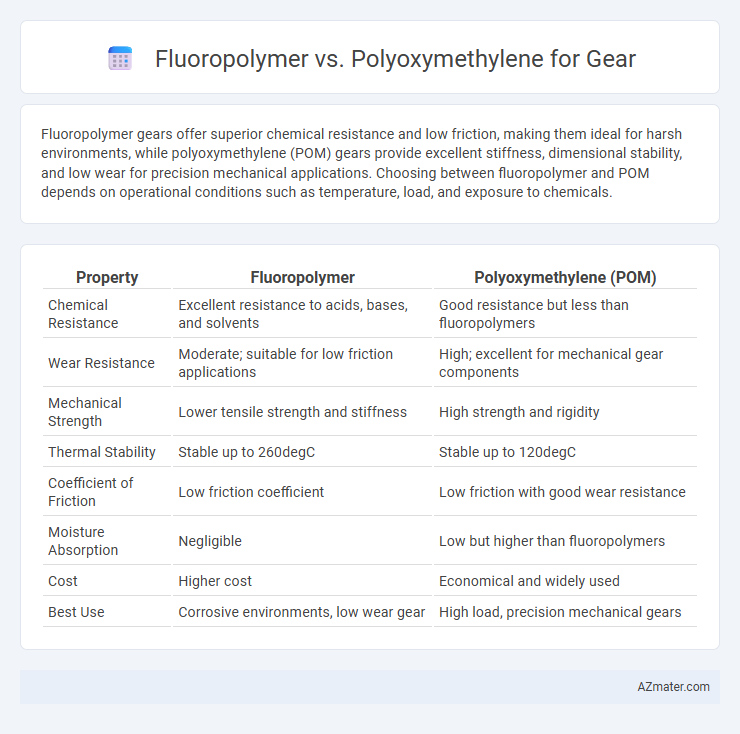Fluoropolymer gears offer superior chemical resistance and low friction, making them ideal for harsh environments, while polyoxymethylene (POM) gears provide excellent stiffness, dimensional stability, and low wear for precision mechanical applications. Choosing between fluoropolymer and POM depends on operational conditions such as temperature, load, and exposure to chemicals.
Table of Comparison
| Property | Fluoropolymer | Polyoxymethylene (POM) |
|---|---|---|
| Chemical Resistance | Excellent resistance to acids, bases, and solvents | Good resistance but less than fluoropolymers |
| Wear Resistance | Moderate; suitable for low friction applications | High; excellent for mechanical gear components |
| Mechanical Strength | Lower tensile strength and stiffness | High strength and rigidity |
| Thermal Stability | Stable up to 260degC | Stable up to 120degC |
| Coefficient of Friction | Low friction coefficient | Low friction with good wear resistance |
| Moisture Absorption | Negligible | Low but higher than fluoropolymers |
| Cost | Higher cost | Economical and widely used |
| Best Use | Corrosive environments, low wear gear | High load, precision mechanical gears |
Introduction to Gear Materials
Fluoropolymers and polyoxymethylene (POM) represent two pivotal materials in gear manufacturing, each offering distinct performance benefits. Fluoropolymers excel in chemical resistance, low friction, and high-temperature stability, making them ideal for harsh environments and demanding applications. Polyoxymethylene, also known as acetal, provides superior mechanical strength, stiffness, and excellent dimensional stability, which is essential for precision gear components in automotive and industrial machinery.
Overview of Fluoropolymers
Fluoropolymers, such as polytetrafluoroethylene (PTFE), exhibit exceptional chemical resistance, low friction, and high thermal stability, making them ideal for gear applications requiring durability and smooth operation. These materials maintain integrity under extreme temperatures and aggressive environments, outperforming polyoxymethylene (POM) in resistance to solvents and corrosive substances. Their inherent self-lubricating properties reduce wear and extend gear lifespan in demanding mechanical systems.
Key Properties of Polyoxymethylene (POM)
Polyoxymethylene (POM) exhibits high tensile strength, excellent dimensional stability, and low friction, making it ideal for precision gears requiring durability and smooth operation. Its superior wear resistance and good chemical resistance enable reliable performance in mechanical applications under moderate stress and temperature conditions. Compared to fluoropolymers, POM offers greater rigidity and load-bearing capacity, essential for long-lasting gear functionality.
Mechanical Strength Comparison
Fluoropolymers offer excellent chemical resistance and low friction but generally exhibit lower mechanical strength and rigidity compared to polyoxymethylene (POM), which is renowned for its high tensile strength, stiffness, and dimensional stability. Polyoxymethylene gears provide superior load-bearing capacity and wear resistance, making them ideal for precision mechanical applications requiring consistent performance under stress. While fluoropolymers excel in environments with harsh chemicals or extreme temperatures, POM gears outperform in structural integrity and mechanical durability.
Wear and Friction Performance
Fluoropolymers exhibit excellent wear resistance and very low friction coefficients, making them ideal for gears operating under high-speed or chemically aggressive environments. Polyoxymethylene (POM) offers superior dimensional stability and strength with good wear resistance but typically has higher friction compared to fluoropolymers. The choice between fluoropolymer and POM for gears depends on the application's need for chemical resistance, load capacity, and friction reduction.
Chemical Resistance Analysis
Fluoropolymers exhibit superior chemical resistance compared to polyoxymethylene (POM), particularly against aggressive solvents, acids, and bases, making them ideal for gear applications in harsh chemical environments. POM offers good mechanical strength and dimensional stability but is susceptible to hydrolysis and degradation when exposed to strong acids or high temperatures. When chemical resistance is critical, fluoropolymer gears provide enhanced durability and longevity, reducing maintenance and failure risks in corrosive conditions.
Thermal Stability Differences
Fluoropolymers exhibit superior thermal stability compared to polyoxymethylene (POM), maintaining performance at temperatures exceeding 200degC, while POM typically degrades around 120-140degC. This enhanced thermal resistance makes fluoropolymers ideal for high-temperature gear applications where continuous exposure to heat can cause POM to lose mechanical strength and dimensional stability. The chemical structure of fluoropolymers, characterized by strong carbon-fluorine bonds, provides this exceptional thermal stability, ensuring longer gear lifespan under thermal stress.
Cost and Manufacturing Considerations
Fluoropolymers offer superior chemical resistance and low friction for gears but come with higher raw material and processing costs compared to polyoxymethylene, which provides excellent dimensional stability and wear resistance at a more affordable price point. Manufacturing fluoropolymer gears typically requires specialized equipment and longer cycle times due to their high melting temperatures and flow challenges, while polyoxymethylene gears benefit from easier machinability and faster injection molding processes. For cost-sensitive applications where precision and durability are critical, polyoxymethylene often presents a more economical manufacturing solution without compromising essential gear performance.
Application Suitability in Gear Systems
Fluoropolymer gears excel in chemical resistance and low friction applications, making them suitable for environments with aggressive chemicals or high temperatures. Polyoxymethylene (POM) offers superior mechanical strength, dimensional stability, and wear resistance, ideal for high-load and precision gear systems. Application suitability hinges on operational conditions: fluoropolymers thrive in corrosive or high-temperature settings, while POM is preferred for durability and rigidity in standard mechanical applications.
Conclusion: Selecting the Optimal Gear Material
Fluoropolymer offers superior chemical resistance and low friction, making it ideal for gears operating in harsh chemical environments or requiring long-term lubrication-free performance. Polyoxymethylene (POM) provides excellent mechanical strength, dimensional stability, and wear resistance, suitable for precision gears under moderate mechanical stress. Selecting the optimal gear material depends on application-specific demands: fluoropolymer suits corrosive, low-load conditions, while POM excels in high-load, precision gear applications.

Infographic: Fluoropolymer vs Polyoxymethylene for Gear
 azmater.com
azmater.com